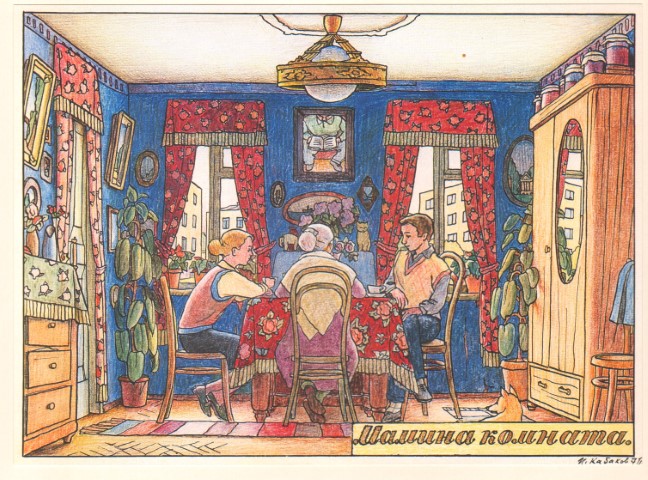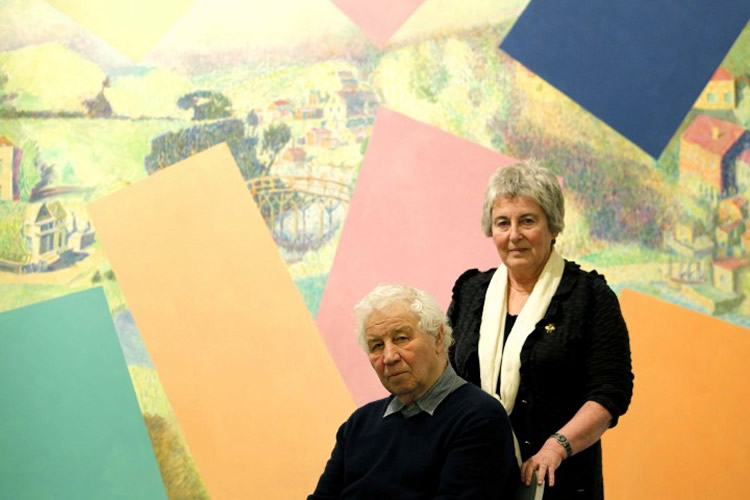OSTEN MUSEUM of Drawing at 6th Art Thessaloniki Fair 2022 is presenting Ilya & Emilia KABAKOV with the multimedia project DREAMS & REALITY.
“DREAMS & REALITY – Four Stories of Escapism”
One of Ilya Kabakov's most famous and most influential works are the albums from the 10 Characters series, which he produced from 1968 – 1974 as an unofficial artist working in Moscow. This edition was issued in 1994-1996, out of which one edition of each album is donated by Kabakovs to the OSTEN Museum of Drawing in Skopje.
While their work is rooted in the Soviet social and cultural context in which the Kabakovs came of age, the subject matters of their artwork extend beyond that experience to engage universal themes of memory, fantasy, and illusion and it became a subject about people in general: their fears and desires to escape from oppressive family situation, country, government, etc..“Ten Characters’ Albums”, particularly the Albums that are to be presented within the project “DREAMS & REALITY – Four Fables of Escapism” are sending universal messages by the characters who are trying to escape from the reality.

Album 1.“Sitting-in-the-Closet Primakov”, 1994, hand-signed print portfolio of 47 sheets, A.P. 9/80, 51 x 35 cm/each(to be exhibited as a wall installation) – is the image of existences in a closed space, isolation of oneself from other people, shutting oneself off in total solitude, in darkness, but “going out” of the closet of such a personage leads not to acquiring life, a real horizon, but still that same emptiness, only now it is not black but white. Through sitting in the closet he is imagining things and then "disappearing" into another world or realm or dream

Album 2. “The Jocker Gorokhov”, 1998, hand signed-print portfolio of 48 sheets, A.P. 38/80, 51 x 35 cm/each(to be exhibited as a wall installation) – is about the “humorous/satirical” attitude toward life that comes under criticism as a way of perceiving one’s surroundings as too light, non-conflictual, because he can only survive if he makes fun out of the reality;
Album 8. “The Decorator Maligin”, 1995, hand-signed print portfolio of 72 sheets, A.P. 12/80, 51 x 35 cm/each (to be exhibited as a wall installation) – is about the impossibility, the lack of desire, to wind up in the “center,” to step out into the “middle,” about the desire to hide in the corner, to be “on the edge,” “on the side” and rather to decorate differently the "real world" which he doesn't like than to live in such a reality;

Album 6. “The Flying Komarov”, 1994, hand-signed print portfolio of 32 sheets, A.P. 31/80, 51 x 35 cm/each(to be presented as a video Installation) - is a utopia of bliss, a state of eternal hovering, suspension between heaven and earth, between a dream and reality, the one who is stepping out from his balcony and flying away, but why?
Committing suicide? Dying? Flying?

All about the ESCAPING!!!
How many people in this world are doing the same, especially now with the pandemic going on for two years and with a danger of next WWIII now being almost a reality? People start trying to escape into dreams, fantasies, cooking, drugs and millions of other things we only can imagine. What are fairy tales, movies, books if not the way to escape from reality even if it’s for a few hours?... and all these are UNIVERSAL FEELINGS/NEEDS/URGES and METHODS of ESCAPISM.
About the “Ten Characters' Albums”
One of Kabakov's major output during the 1970s (besides the paintings created in that time period including his first conceptual painting “The Soccer Player”, 1964) consisted of albums like this one: collections of drawings and text assembled in "books" of 30 to 100 pages each and performed for friends and fellow artists at Kabakov's famous Sretensky Boulevard attic studio. The 10 Characters albums were the first of this genre Kabakov created and remain the most influential on his later work and on ex-Soviet contemporary art in general. This series of albums can be seen as a turning point for Kabakov. The ten albums tell ten fables: they suggest ten positions from which a person can react to his world, ten psychological attitudes, ten perspectives on emptiness, ten parodies of the aesthetic traditions through which Kabakov evolved his vocabulary, ten aspects of Kabakov’s personality.
“10 Characters’ Albums” have been exhibited individually and collectively in museums around the world. The originals are in the collections of the Centre Pompidou in Paris. A two-volume catalogue was printed in 1995 to accompany exhibitions in the Contemporary Art Museums of Helsinki and Oslo.
Kabakov’s are holders of the GRAND PRIX for Lifetime Achievement at the OSTEN BIENNIAL of DRAWING Skopje 2020 and they are presented in the Biennial’s catalog by the text of prof. Manos Stefanidis “Kabakov: Ten Albums”.
About the artists Ilya & Emilia KABAKOV

Kabakovs are Russian-born, American-based artists that collaborate on environments that fuse elements of the everyday with those of the conceptual. While their work is deeply rooted in the Soviet social and cultural context in which the Kabakovs came of age, the subject matters of their artwork extend beyond that experience to engage universal themes of memory, fantasy, and illusion.
Ilya Kabakov was born in Dnepropetrovsk, Soviet Union, in 1933. He studied at the VA Surikov Art Academy in Moscow, and began his career as a children’s book illustrator during the 1950’s. He was part of a group of Conceptual artists in Moscow who worked outside the official Soviet art system. In 1985 he received his first solo show exhibition at Dina Vierny Gallery, Paris, and he moved to the West two years later taking up a six months’ residency at Kunstverein Graz, Austria. In 1988. Kabakov began working with his future wife Emilia (they were to be married in 1992). From this point onwards, all their work was collaborative, in different proportions according to the specific project involved.
Emilia Kabakov (née Lekach) was born in Dnepropetrovsk, Soviet Union, in 1945. She attended the Music College in Irkutsk in addition to studying Spanish language and literature at the Moscow University. She immigrated to Israel in 1973, and moved to New York in 1975, where she worked as a curator and art dealer. Emilia has worked side by side with Ilya since 1989.
Today Kabakov is recognized as the most important international artist to have emerged in the late 20th century. His installations speak as much about conditions in post-Stalinist Russia as they do about the human condition universally. Their work has been shown in such venues as the Museum of Modern Art, the Hirschhorn Museum in Washington DC, the Stedelijk Museum in Amsterdam, Documenta IX, at the Whitney Biennial in 1997 and the State Hermitage Museum in St. Petersburg, among others. In 1993 they represented Russia at the 45th Venice Biennale with their installation The Red Pavilion. The Kabakovs have also completed many important public commissions throughout Europe and worldwide and have received a number of honors and awards, including the GRAND PRIX for Lifetime Achievement at the OSTEN BIENNIAL of DRAWING Skopje 2020, N. Macedonia; Oscar Kokoschka Prize, Vienna 2002, Austria; the Chevalier des Arts et des Lettres, Paris, in 1995, and many more…
The Kabakovs live and work in Long Island, USA.
A MESSAGE FROM ARTIST EMILIA KABAKOV, who, with Ilya Kabakov, was behind the inspiring international project The Ship of Tolerance that Art Refuge was privileged to be part of a few years ago: We don't choose when and where we are born. We don't choose when and where we die. But we definitely choose whom we become, how we live our life and, if we are lucky, where we live. Ilya and I were born in Dnipropetrovsk, Ukraine. Live in Moscow/well, I was taken back to Dnipropetrovsk in 1958, when my parents were arrested trying to leave USSR, and then come back to Moscow in 1971. Living there without documents /propiska/. But I always knew that I will leave. That this is not the country I want and will live and bring up my children. It was almost impossible, but in 1973 I was the first person to emigrate from the same Dnipropetrovsk. This was the city of my grandfather family for 400 years! Ilya and I always were adamant to say that we are INTERNATIONAL ARTISTS! And we still want
to say this again. International community managed to come to the point when artists, musicians, poets, writers from EVERY LITTLE COUNTRY, EVERY CORNER OF EARTH started to work together. And right now, despite everything, we all stand together in our believe, that WE ALL ARE IN THIS TOGETHER for FREEDOM, for DIGNITY, for MORAL INTEGRITY of EVERY HUMAN BEING.
WE ARE FOR MAKING THIS LIFE BETTER, SAFER, FOR EVERY CHILD ON EARTH. And it’s a CRIME OF UNHUMAN PROPORTION TO MAKE PEOPLE SUFFER AS PEOPLE IN UKRAINE ARE SUFFERING NOW.
OSTEN Skopje
Kornelija KONESKA, CEO
Skopje, 24 March 2022




